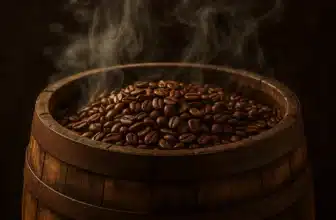
OneHundredCoffee is reader-supported, and some products displayed may earn us an affiliate commission. Details
We Brewed the Same Coffee Beans 5 Ways—Here’s What Tasted Best
I’ve always loved the tiny experiments that make coffee feel like both a ritual and a science project. One Saturday, I pulled out five brewers, weighed a single bag of beans, and decided to answer a question I get all the time: Does the brew method really change flavor that much if the coffee is the same? Short answer: yes—wildly. Long answer: buckle up. I brewed the same beans five ways—pour-over, French press, AeroPress, espresso, and cold brew—keeping everything else as consistent as possible. What I learned surprised me, delighted me, and changed how I recommend brew gear to friends. Here’s the full taste-test story, and which cup I’d pick for different moods.

Elegant French Press with stainless filtration and heat-resistant glass. Brews bold, rich coffee in minutes with no mess.
Price on Amazon
Reusable stainless steel filter with borosilicate glass. Control every pour for smooth, balanced, and flavorful coffee anytime.
Price on Amazon
Fast and portable coffee press with low bitterness and no grit. Ideal for home, travel, or camp brewing adventures.
Price on Amazon
Classic Italian moka pot for rich stovetop espresso. Sleek design and easy pour spout for mess-free brewing.
Price on Amazon
Cold brew made easy with this airtight, BPA-free coffee maker. Smooth taste and perfect for fridge storage.
Price on AmazonThe Setup: One Coffee, Five Methods, Clean Variables
I started with a fresh, medium-light roast with a flavor profile most of us enjoy: citrus brightness, milk chocolate sweetness, and a hint of toasted nuts. Single-origin beans work great, but balanced blends make differences easier to taste. Here’s how I kept the test fair:
- Water: filtered, ~94°C (201°F) for hot brews.
- Coffee dose: standardized by beverage strength, not “one scoop each.”
- Ratios:
- Pour-over: 1:16
- French press: 1:15
- AeroPress: 1:12 (top up with hot water to taste)
- Espresso: ~1:2 (18 g in → 36 g out)
- Cold brew: 1:5 concentrate, diluted 1:2 to serve
- Grind sizes: dialed to target extraction for each method (finer for espresso; coarser for press).
- Freshness: beans roasted within two weeks; ground immediately before brewing.
- Repeatability: I brewed each method twice and averaged the notes from both rounds.
One practical note before diving in: grind size is the steering wheel. If you take nothing else from this, remember that.
Method 1: Pour-Over (V60) — The “Studio Monitor” Cup
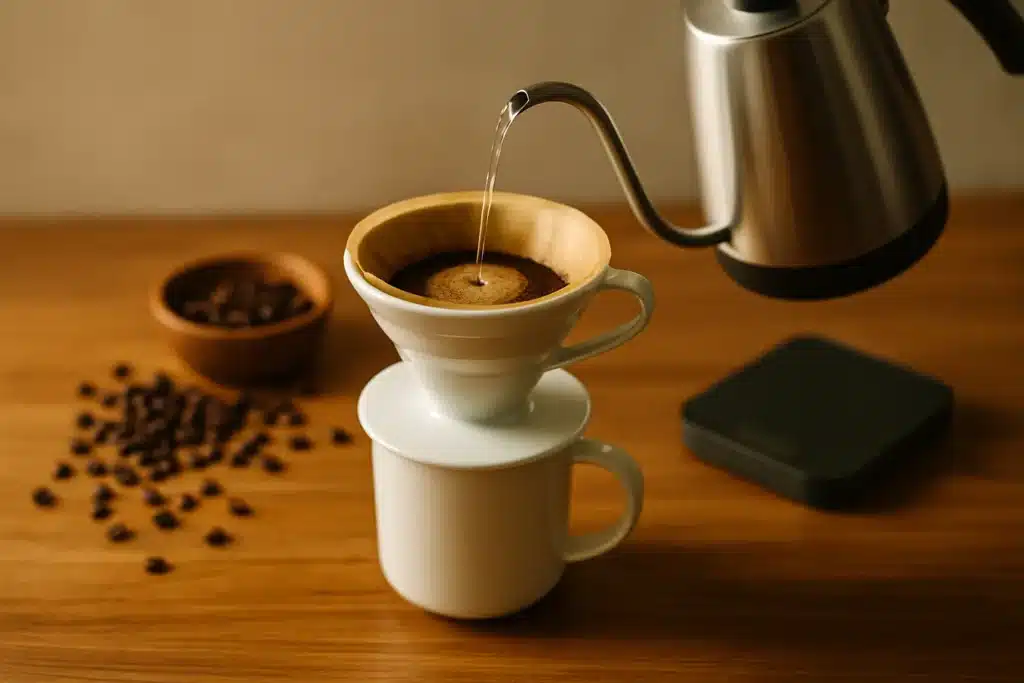
Recipe: 20 g coffee, 320 g water at 94°C, 30-second bloom, total 2:45–3:00. Medium-fine grind.
Pour-over is what I think of as the “studio monitor” of brewing—like flat, accurate speakers. It shows you exactly what’s in the beans. With this coffee, the V60 made the citrus pop in a way none of the other brews did. The lemony brightness felt like a line drawn with a sharp pencil. The milk-chocolate sweetness sat politely in the mid-palate, and the finish was brisk, almost tea-like.
What stood out: clarity and separation. Aromas lifted cleanly; aftertaste was short and refreshing. If you like sparkling acidity, pour-over is your friend.
Downside: it’s honest to a fault. Any roast defects or staleness show up immediately. Also, pour-over is sensitive to pouring technique; inconsistent pours mean inconsistent flavor.
Who it’s for: people who love nuanced, clean coffees and enjoy a mindful morning ritual.
Method 2: French Press — The “Vinyl Record” Cup
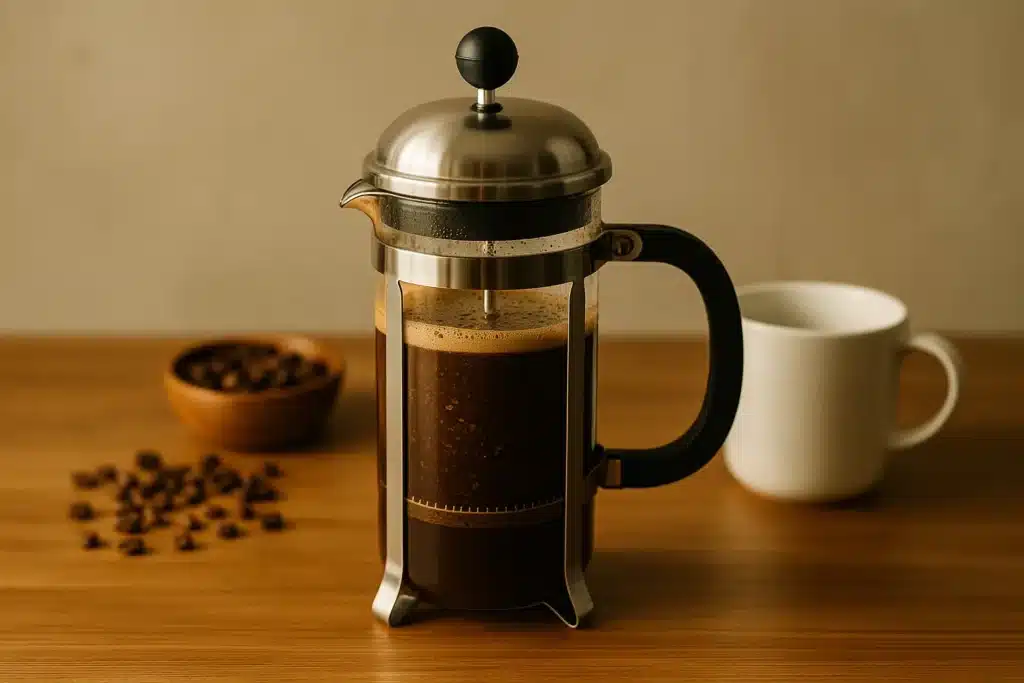
Recipe: 24 g coffee, 360 g water at 94°C. Coarse grind. 4 minutes steep, stir and skim oils/foam, press gently, decant immediately.
French press is the “vinyl record” of our test: rich, warm, and a little romantic. The press brought the milk-chocolate and nut notes forward and massaged the acidity into something round and easy. The body was full and silky; there’s a light sediment if you don’t use a secondary filter, which I actually enjoy—it feels rustic and cozy.
What stood out: texture and comfort. The citrus became marmalade rather than lemon zest; flavors blurred into a delicious, cohesive whole.
Downside: clarity takes a hit compared to paper-filtered methods. If you dislike any grit, you’ll want a finer metal screen or a cloth filter.
Who it’s for: people who want a plush, full-bodied mug that can stand up to milk or a buttery croissant.
Method 3: AeroPress — The “Switch Hitter” Cup
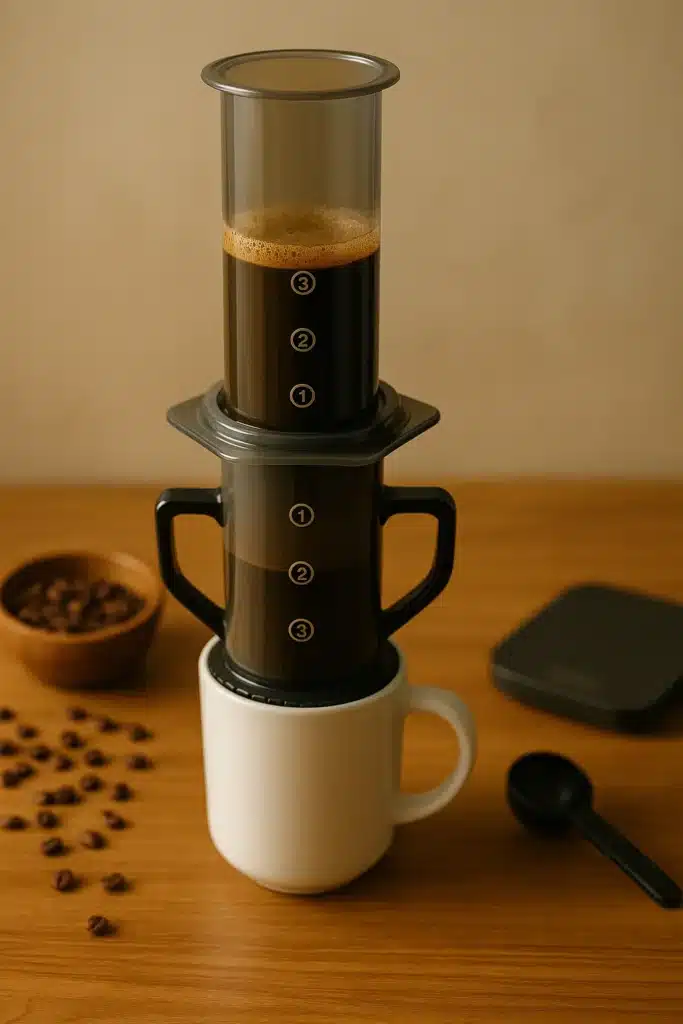
Recipe: Inverted. 17 g coffee, 200 g water at 85–90°C. Medium grind. 1:15 steep, 20-second stir, 30-second press. Top up with hot water to taste.
AeroPress is the multi-tool of coffee. It can mimic pour-over clarity or flirt with espresso-like intensity, all in a compact brew. With this bean, I aimed for a sweet, rounded cup with balanced acidity. It worked. I got candied orange, honeyed sweetness, and a creamy mouthfeel that felt surprisingly luxurious for a paper-filtered brew.
What stood out: balance and versatility. The cup tasted “complete,” like the coffee’s EQ curve was gently boosted where it mattered.
Downside: recipes vary wildly; a few degrees or seconds can shift the cup. The good news is that those shifts are almost always tasty.
Who it’s for: travelers, tinkerers, and anyone who wants café-quality coffee without a lot of gear.
Method 4: Espresso — The “Technicolor” Shot
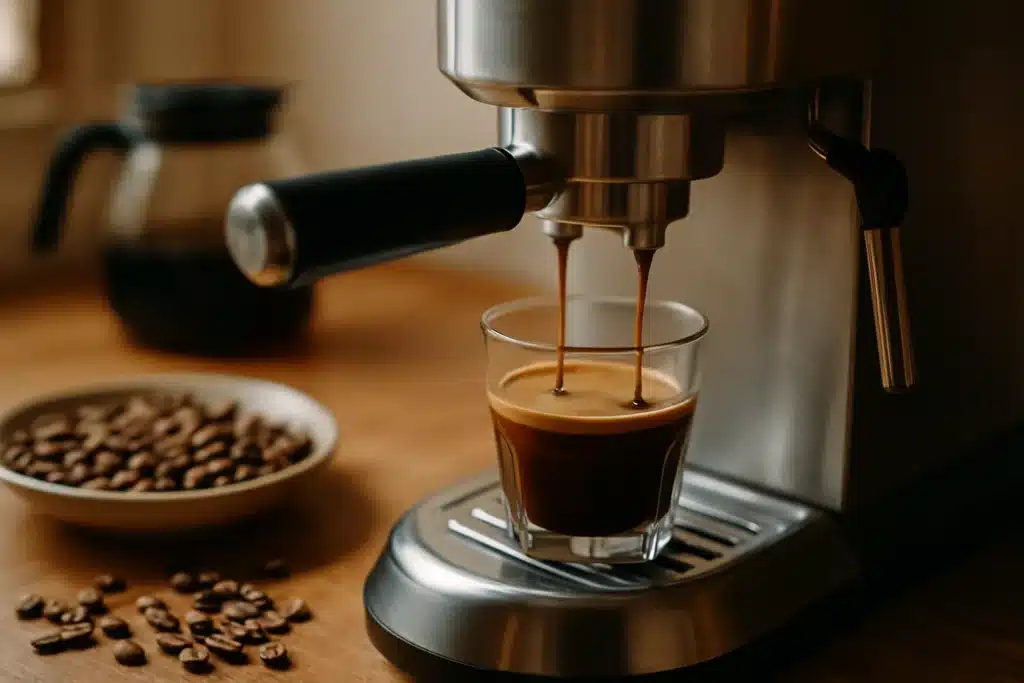
Recipe: 18 g in, 36 g out in 27–30 seconds. Fine grind. 9 bars, ~93°C.
Espresso is concentrated reality. It takes the same flavor set and explodes it into Technicolor. My shots were viscous and syrupy, with dark chocolate, orange peel, and a tiny ribbon of almond. On its own, the acidity felt more pointed, but as soon as I added a splash of steamed milk, the chocolate turned to cocoa-powder brownie, and the citrus became caramelized orange.
What stood out: intensity and the way small changes flip the cup. Adjusting the rind by a hair turned “a bit sharp” into “oh wow” on the next pull.
Downside: effort and gear. Dial-in matters, and equipment quality show Espresso has the narrowest window for “perfect.”
Who it’s for: flavor chasers, milk-drink folks, and anyone who likes precision dressed up as magic.
Method 5: Cold Brew — The “Low-and-Slow” Cup
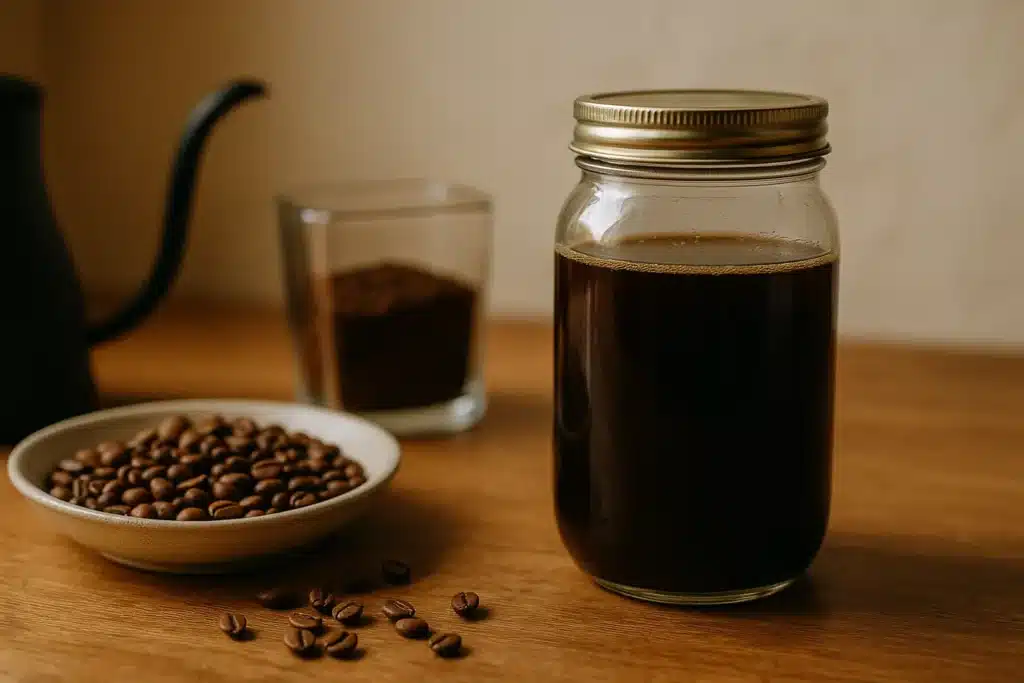
Recipe: 100 g coffee, 500 g cold water. Coarse grind. 16 hours in the fridge. Filter concentrate 1:2 with water or ice.
Cold brew is long, smooth, and mellow—like a slow jam. It took the lemony sparkle of our beans and turned it into a sweet orange and chocolate truffle, with a plush texture that stayed gentle even as it warmed. Over ice, it was dangerously easy to drink.
What stood out: silky sweetness and near-zero bitterness. Great for hot climates or for people sensitive to acidity.
Downside: some nuance gets muffled; if you love floral aromatics, this can feel too rounded. Also, you need to plan.
Who it’s for: iced-coffee devotees, batch brewers, and anyone who wants an easy, forgiving crowd-pleaser.
Side-by-Side Results (What We Actually Tasted)
Below is the snapshot I wish someone had given me before I started experimenting. It shows how the same beans landed in the cup across five methods—not theoretical, but what we tasted.
| Brew Method | Cozy morning mug, with pastries | Body/Texture | Perceived Acidity | Best Use Case | Grind Target | Difficulty |
|---|---|---|---|---|---|---|
| Pour-Over (V60) | Lemon zest, milk chocolate finish, tea-like clarity | Light to medium, silky | Bright, sparkling | Sipping black; flavor exploration | Medium-fine | Medium (pour control) |
| French Press | Milk chocolate, toasted nuts, marmalade | Full, creamy, slight sediment | Gentle, rounded | Cozy morning mug; with pastries | Coarse | Easy (timing matters) |
| AeroPress | Candied orange, honey, balanced sweetness | Medium, creamy | Balanced | Travelers; quick café-quality at home | Medium | Easy-Medium |
| Espresso | Dark chocolate, orange peel, almond | Syrupy, dense | High but integrated | Straight shots; cappuccinos/flat whites | Very fine | Hard (dial-in) |
| Cold Brew | Chocolate truffle, sweet orange, low bitterness | Plush, velvety | Low | Iced coffee; big batches; hot climates | Coarse | Easy (long wait) |
Which Tasted Best? It Depends on What You Value
I’ll give you a straight answer and then the nuance.
- If I could only pick one cup to drink black, Pour-over would win by a nose. The clarity with these beans was addictive; it felt like a hi-fi rendition of everything the roaster intended.
- If I wanted the most comforting mug, French press was the hug in a cup—round, chocolatey, and endlessly sippable.
- If I wanted the best all-rounder for weekdays, AeroPress delivered the most consistent joy with the least fuss.
- For milk drinks or dessert coffee: Espresso in a flat white transformed the same flavors into something luscious and dessert-adjacent.
- For make-ahead and iced: Cold brew crushed it—sweet, soft, and refreshing without a hint of harshness.
In blind tasting, our small panel (okay, three friends and me) overwhelmingly preferred AeroPress for everyday drinkability and espresso with milk as a treat. But on a quiet morning with time to breathe, a pour-over was the cup we kept talking about.
The Science-ish Bit (Without the Jargon Trap)
When you keep beans the same, differences come from extraction (how much soluble stuff you pull out) and filtration (what gets left behind). Paper filters (V60, AeroPress) remove oils and fines, creating clarity and a cleaner finish. Metal or no filter (French press, espresso’s metal basket) keeps oils and microscopic particles in the cup, which boosts body and can make flavors feel rounder. Cold water changes what dissolves and how fast, favoring sweetness over acidity.
Grind size dictates surface area; finer grinds extract faster. Water temperature changes solubility; hotter water grabs more acids and aromatics quickly. Brew time is your third lever—steeping longer shifts the balance from “sparkly” to “rounded.”
None of that is trivia; it’s the practical “why” behind what you’ll taste.
How to Choose Your Daily Method (Based on You, Not Me)
- You love fruit-forward, articulate coffees: choose pour-over. Spend your attention on the pour rate and grind.
- You want comfort and chocolate: go French press. Don’t fear the minor sediment; it’s part of the charm.
- You need speed, portability, and flexibility: AeroPress will be your best friend.
- You adore milk drinks or concentrated flavor: espresso is worth the learning curve.
- You live somewhere warm or want a fridge-ready option: cold brew makes weekdays frictionless.
And remember: you don’t have to marry one method. I rotate based on mood, weather, and whether I’m sipping slowly or drinking before a hectic day.
Our Baseline Recipes You Can Copy (And Then Tweak)
Pour-Over (V60): 20 g coffee, 320 g water. Bloom with 40 g for 30 seconds. Two or three steady center-out pulses to 320 g by 2:00. Aim to finish dripping by 3:00. If sour, grind finer; if bitter, grind coarser.
French Press: 24 g coffee, 360 g water. Pour all at once, stir, lid on. At 4:00, stir, skim foam, press gently, and decant immediately. If muddy, try a slightly coarser grind or a secondary paper filter when decanting.
AeroPress (Inverted): 17 g coffee, 200 g water at 88–90°C. Pour, quick stir, cap with rinsed paper, steep 1:15; flip and press over 30 seconds. Top up with hot water to ~240–260 g in the cup. Adjust water temp for more/less acidity.
Espresso: Start with 18 g in, 36 g out in ~28 seconds at ~93°C. Taste and adjust grind 1–2 clicks at a time. If astringent, pull shorter or grind coarser. If sour/under, grind finer or increase temperature slightly.
Cold Brew: 100 g coffee, 500 g water in a jar. Stir, chill 16 hours. Strain through a fine filter, then a paper filter. Dilute concentrate 1:2 with water or ice. If flat, try a slightly finer grind or a 1:4 brew ratio.
Troubleshooting: Why Your Cup Doesn’t Match the Notes
- Dull or flat flavor: coffee is too old, the grind is too coarse, or the water is too cool. Try a tighter grind and hotter water.
- Sourness: under-extracted; make grind finer, increase brew time, or raise temperature.
- Bitterness/astringency: over-extracted; grind coarser, shorten contact time, lower temperature.
- Muted aromatics in press or cold brew: accept the style, or switch to a paper-filtered method when you crave sparkle.
One more tip: weigh your brewing water. “Fill to the line” is inconsistent; scales make coffee more repeatable than any fancy kettle.
Flavor Profiles: How the Same Beans Shape-Shift
Tasting the same beans across methods taught me to expect shape-shifting. Here’s the pattern I noticed and now use as a guide:
- Pour-Over → citrus brightens, florals sing, finish tightens.
- French Press → chocolate/nut deepen, acidity softens, mouthfeel expands.
- AeroPress → sweetness concentrates, edges round, balance increases.
- Espresso → everything amplifies; acids get spiky but integrate with correct yield.
- Cold Brew → chocolate dominates, acidity dips, sweetness glides.
So the next time you taste a coffee and think “not for me,” try a different method before you give up on the beans.
Brewing for Milk vs. Black (Same Beans, Different Destination)
These beans were lovely black in pour-over and AeroPress, but in milk drinks, the espresso version took over the room. Milk acts like an EQ—softening high notes and boosting mid-bass. If you mostly drink cappuccinos, pick brew methods that deliver density and caramelized sweetness (espresso, moka, or even a stronger AeroPress recipe). For black coffee, lean into clarity (pour-over) or texture (press).
Cost, Cleanup, and Convenience (Because Real Life Matters)
- Pour-Over: Cheap gear, medium effort, quick cleanup. Needs a good kettle and patience.
- French Press: Very affordable, minimal technique, slightly messier clean up, but zero paper filters.
- AeroPress: Mid-range price, small, fast cleanup, perfect for travel/work.
- Espresso: Highest cost and effort; steep learning curve, but the ceiling is very high.
- Cold Brew: Cheapest per cup if you batch; long wait but zero morning effort.
If you’re building a small k kir nder first. It’s the single biggest upgrade you can make, regardless of method.
The Best 5 Coffee Bean Picks (Amazon-Available) to Try This Experiment Yourself
If you want to run your own five-way tasting, pick beans that show character in multiple brewers. Here are five crowd-pleasers that are widely available on Amazon in the U.S. and rotate flavors nicely across methods (no links—just names you can search):
- Stumptown Coffee Roasters – Hair Bender (balanced, chocolate-citrus; shines in espresso and pour-over)
- Kicking Horse – Kick Ass (bold, chocolaty; French press and cold brew dream)
- Peet’s Coffee – Big Bang (bright tropical notes; great for AeroPress and V60)
- illy – Classico Whole Bean (silky, sweet; consistent for espresso and moka)
- Café Bustelo – Espresso Roast (budget-friendly, robust; great for moka/espresso-style and cold brew concentrates)
Rotate through the and n d you’ll instantly feel how the method decides the storyline while the beans provide the cast.
Mini-Guide: Dial-In Flowchart (Human, Not Robot)
I keep a simple mental flowchart when a cup isn’t clicking:
- Too sour? Finer grind → slightly hotter water → a touch more time.
- Too bitter? Coarser grind → cooler water by a degree or two → slightly less time.
- Thin body? Finer grind or higher dose; for paper filters, consider a method with more oils (press/AeroPress metal cap).
- Muted aroma? Use fresher beans, try a paper filter, raise water temp, or shorten bloom only if it’s very long.
This isn’t dogma—just the path I follow 95% of the time.
What I’d Do Differently Next Time
If I reran this experiment, I’d add a Moka pot and a Kalita Wave for their distinct structure. I’d also measure TDS to correlate taste with numbers, not because numbers make better coffee, but because they teach you what your palate is already feeling.
I’d also repeat with a natural-processed coffee to see how the berry-jam character behaves in cold brew versus espresso. My hunch: the cold brew would be dessert, and the espresso might need a slightly coarser grind or lower temp to tame the fruit-leather punch.
Frequently Asked Questions (Because You’re Probably Thinking These)
Can I use pre-ground coffee for this?
You can, but your results will vary more. Grind size is the steering wheel. If you must, choose the method that matches the grind (e.g., pre-ground “filter” for pour-over or drip; “espresso” for moka/espresso).
Do I really need a gooseneck kettle?
It helps for pour-over, but isn’t essential. A steady hand and consistent flow beat fancy gear.
Is cold brew less acidic for my stomach?
Many people find it gentler. It’s not “less acidic” in a chemistry sense across the board, but it tastes lower in acidity and often feels smoother.
What’s the best grinder setting?
There isn’t one. Start with general guidelines (fine for espresso, medium-fine for pour-over, coarse for press/cold brew) and taste forward.
What water should I use?
Filtered tap water is usually perfect. If your water tastes great alone, it’ll brew great coffee. If it tastes like a swimming pool, filter it.
The Verdict, For Real
After two rounds with the same beans across five brew methods, here’s my human, hand-on-heart conclusion:
- Pour-over gave me the most beautiful black cup—clean, precise, and emotionally satisfying in its clarity.
- French press gave me the most comfort—flavors folded into each other like a warm blanket.
- AeroPress gave me the most daily joy with the least fuss—sweet, balanced, adaptable.
- Espresso gave me the most wow—a small drink with a huge personality, especially with milk.
- Cold brew gave me the easiest pleasure—sweet, smooth, and ready when I am.
If you came here for a single winner, it’s the AeroPress for everyday practicality and pour-over for black-coffee lovers. But the real lesson is better: you can keep the same beans and choose your own story each day. Method isn’t just equipment; it’s mood, time, and intention.
So try your own five-way flight. Use one bag of beans and make a week of it. Take notes (quick words like “zest,” “cocoa,” “smooth”), adjust grind, and feel your palate sharpen. Coffee gets more interesting not when you chase a perfect cup, but when you notice what changes the cup and why. That’s where the fun—and the flavor—lives.



